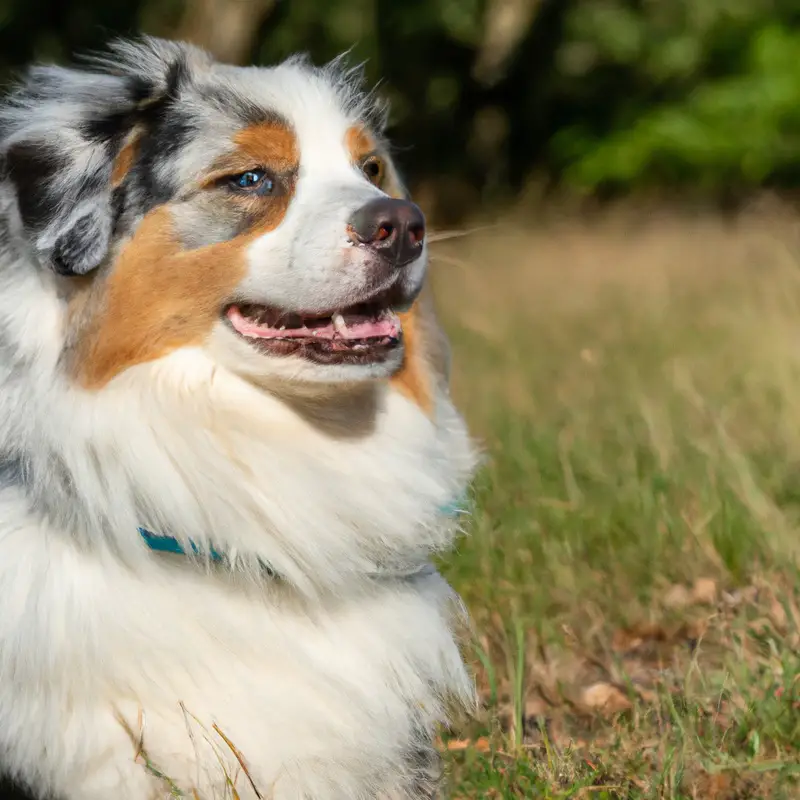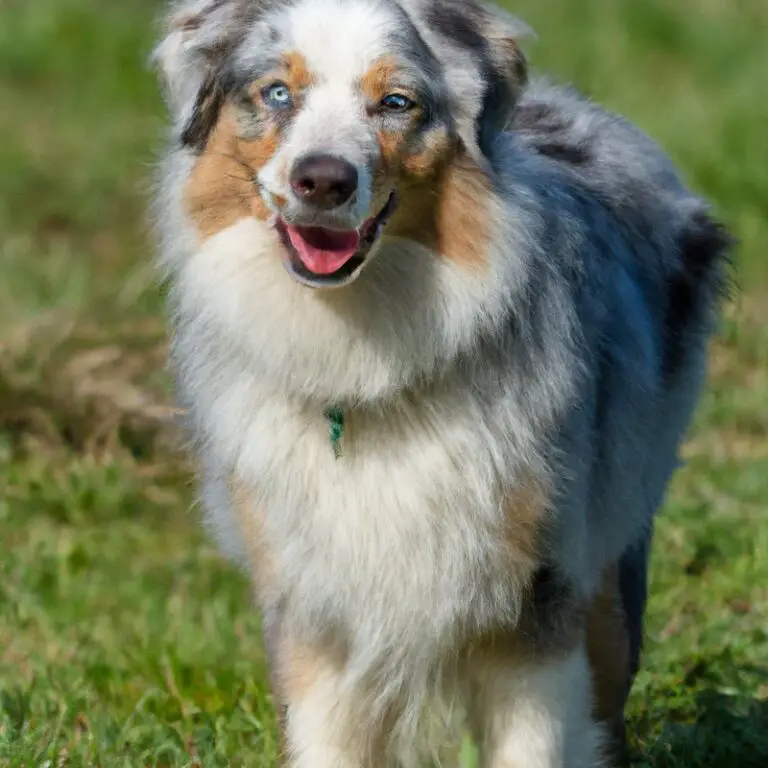How Do Australian Shepherds Behave When Introduced To New Small Mammals Like Hamsters?
Key Takeaways:
- Australian Shepherds may exhibit curious and inquisitive behavior when introduced to small mammals like hamsters.
- They might display herding instincts towards these smaller animals due to their natural tendencies.
- Proper socialization and training can help Australian Shepherds develop positive behavior and interactions with small mammals like hamsters.
- It is important to closely supervise these interactions to ensure the safety of both the Australian Shepherd and the small mammal.
Are you a proud Australian Shepherd owner? Do you also have small mammals like hamsters as pets?
If so, you might be wondering how your beloved Aussie will react when introduced to these tiny critters.
Well, fear not! As an expert in canine behavior, I’m here to provide you with some insights on how Australian Shepherds behave when encountering new small mammals. From understanding their prey drive to preparing the environment for a safe introduction, I’ll share tips and techniques to ensure a harmonious coexistence.
So, grab your coffee, sit back, and let’s delve into the fascinating world of Aussie interactions with small mammals!
| Australian Shepherds | Hamsters |
|---|---|
| High energy level | Low energy level |
| Herding instinct | Predatory instincts |
| Social and friendly | Solitary and territorial |
| Require mental and physical stimulation | Minimal mental and physical stimulation required |
| Curious and inquisitive | Timid and skittish |
| May try to herd or chase | May be frightened or stressed |
| Tendency to bark or nip | Quiet and non-aggressive |
Understanding Australian Shepherds’ Prey Drive
What is Prey Drive?
Prey drive refers to an instinctive behavior in dogs that compels them to chase, capture, and potentially harm small animals. It is an innate characteristic that is deeply rooted in a dog’s nature, particularly in certain breeds.
Prey drive is influenced by a combination of genetics and learned experiences.
Dogs with high prey drive are more likely to exhibit intense focus, determination, and agility when pursuing prey. This instinct can be seen in Australian Shepherds, as they were originally bred to work on farms herding and protecting livestock.
Understanding a dog’s prey drive is essential for responsible pet ownership and for managing their interactions with small mammals like hamsters.

The Prey Drive in Australian Shepherds
The Prey Drive in Australian Shepherds refers to their natural instinct and desire to chase, capture, and potentially harm small animals. It is a characteristic that stems from their herding heritage.
Australian Shepherds have a strong prey drive, which can be seen in their intense focus, agility, and speed when in pursuit of small mammals.
This instinctual behavior can make it challenging to introduce them to small animals like hamsters. It is essential to understand and manage their prey drive to ensure the safety and well-being of all animals involved.

Factors Influencing Prey Drive in Australian Shepherds
There are several factors that can influence the prey drive in Australian Shepherds. Firstly, genetics play a significant role.
Australian Shepherds were originally bred as working dogs, which means they have a strong innate drive to chase and capture prey.
Secondly, early socialization and exposure to different animals can also influence their prey drive. If a puppy is not introduced to small mammals like hamsters at a young age, they may view them as prey rather than as potential companions.
This can result in a heightened prey drive when they encounter these animals later on.
Thirdly, training and reinforcement techniques can also impact a dog’s prey drive. Positive reinforcement training methods that focus on rewarding desired behavior rather than punishment can help redirect and manage the prey drive.
Consistent training and reinforcement can help a dog understand what is acceptable behavior around small mammals.
Lastly, individual temperament and personality can also play a role. Some Australian Shepherds may naturally have a higher prey drive than others.
It’s important for owners to be aware of their dog’s unique temperament and provide appropriate training and management strategies to ensure the safety and well-being of small mammals in their care.
By considering these factors and working with a professional trainer if needed, Australian Shepherd owners can help manage and control their dog’s prey drive when introducing them to small mammals like hamsters. It’s crucial to prioritize the safety and welfare of all animals involved and create a harmonious environment for everyone.
Introducing Australian Shepherds to Small Mammals
Preparing the Environment for Introduction
To prepare the environment for introducing Australian Shepherds to small mammals, such as hamsters, there are a few steps you can take. First, create a safe and secure space for both the dog and the small mammal.
This can involve setting up separate living areas or enclosures to prevent any potential harm or stress.
Next, gradually introduce the dog and the small mammal under controlled circumstances. This can be done by using baby gates or crates to create a barrier between the two while allowing them to see and smell each other.
This controlled introduction helps to assess the dog’s behavior and reaction towards the small mammal.
During the initial interactions, it is important to closely supervise the dog and the small mammal. Observe their behavior and look for any signs of discomfort or aggression.
If any warning signs arise, it’s best to separate them immediately and seek professional help if needed.
Positive reinforcement training can also be beneficial in ensuring a harmonious environment. By rewarding the dog for calm and appropriate behavior around the small mammal, you can help create positive associations and encourage coexistence.
Lastly, providing safety and security is crucial for the small mammal.
This includes creating secure enclosures or cages that the dog cannot access, and exercising caution when allowing interactions. It’s important to remember that each dog and small mammal is unique, so individualize your approach and always prioritize the well-being of both animals.

Controlled Introduction Techniques
When introducing Australian Shepherds to small mammals like hamsters, it’s important to use controlled introduction techniques. Here’s how you can ensure a safe and positive interaction:
- Start with scent swapping: Before any face-to-face interaction, allow your Australian Shepherd to familiarize themselves with the scent of the small mammal. Swap bedding or toys between the two to get them used to each other’s smells.
- Use a barrier or crate: Set up a barrier or use a crate that allows both animals to see and smell each other without direct contact. This provides a controlled environment for introduction and helps prevent any aggressive behavior.
- Slowly increase interaction: Gradually introduce your Australian Shepherd and the small mammal in controlled sessions. Start with short periods of supervised interaction and gradually increase the duration over time.
- Reward positive behavior: Use positive reinforcement techniques to reward your Australian Shepherd for calm and gentle behavior around the small mammal. This helps them associate the presence of the small mammal with positive experiences.
- Stay vigilant: Always monitor the interaction between your Australian Shepherd and the small mammal. Watch for any signs of stress, fear, or aggression from either animal and intervene if necessary.
Remember, each Australian Shepherd may have a different temperament, so it’s crucial to assess their individual behavior and adjust the introduction techniques accordingly. If you have any concerns or if the interaction becomes problematic, it’s best to consult a professional trainer or behaviorist for guidance.
Supervising the Interaction
Supervising the interaction between Australian Shepherds and small mammals like hamsters is vital to ensure their safety. I always keep a close eye on them when they are together to prevent any potential harm.
It’s important to create a controlled environment and ensure that both animals are comfortable.
I make sure that the small mammal is in a secure enclosure and that the Australian Shepherd is on a leash or confined to a designated area. By supervising their interaction, I can intervene if any signs of discomfort or aggression arise.
It’s crucial to prioritize the safety of both animals and seek professional help if needed.
Remember, careful supervision is key for a positive and safe interaction!
Signs of Discomfort or Aggression
Warning Signs to Watch for
Warning Signs to Watch for: When introducing Australian Shepherds to small mammals like hamsters, it’s important to be aware of warning signs that indicate discomfort or aggression. Here are some signs to watch for:
- Stiff body posture: If your Australian Shepherd’s body becomes stiff and tense, it may indicate that they are feeling threatened or agitated. This can be seen in their posture, with their muscles appearing tight and their tail held high.
- Dilated pupils: Pay attention to your dog’s eyes. If their pupils are dilated, it may indicate that they are feeling anxious or aroused. This can be a sign of potential aggression or prey drive.
- Growling or snarling: Vocalization is another important indicator. If your Australian Shepherd starts growling or snarling at the small mammal, it’s a clear warning sign of aggression. This behavior should not be ignored.
- Excessive barking: An Australian Shepherd that is continuously barking or displaying excessive vocalization when introduced to a small mammal may be exhibiting signs of discomfort or fear. This can escalate to aggression if not addressed.
- Excessive focus: If your dog becomes overly focused on the small mammal and is unable to redirect their attention, it could be a sign that their prey drive is kicking in. This means they may be fixated on the potential prey and could act impulsively.
It’s important to closely monitor your Australian Shepherd’s behavior when introducing them to small mammals. If you notice any of these warning signs, it’s best to intervene and remove the dog from the situation.
Remember, your dog’s safety, as well as the safety of the small mammal, should always be prioritized.
Steps to Take when Discomfort Arises
When you notice signs of discomfort or aggression from your Australian Shepherd when introducing them to small mammals like hamsters, it’s important to take immediate action. Here are some steps you can take:
- Separate the animals: If your Australian Shepherd shows signs of discomfort or aggression, it’s crucial to separate them from the small mammal immediately. This will prevent any potential harm to both animals and give them a chance to calm down.
- Assess the situation: Take a moment to understand what may have triggered your Australian Shepherd’s response. Was it a sudden movement, a particular scent, or a territorial instinct? Identifying the cause can help you address the issue more effectively.
- Provide a calm environment: Create a peaceful and quiet space for your Australian Shepherd to retreat to. This will help them relax and reduce stress levels. Consider using soothing music or aromatherapy to further promote a calm atmosphere.
- Gradual reintroduction: Once both animals have had time to calm down, you can try introducing them again in a controlled manner. Start with brief interactions and gradually increase the duration as they become more comfortable with each other.
- Positive reinforcement: Reward your Australian Shepherd with treats and praise when they exhibit calm and appropriate behavior around the small mammal. This positive reinforcement will help reinforce good behavior and promote a harmonious relationship.
- Seek professional help: If you’re having difficulty managing your Australian Shepherd’s discomfort or aggression, don’t hesitate to seek guidance from a professional dog trainer or animal behaviorist. They can provide personalized advice and techniques to address the specific situation.
Remember, patience, consistency, and understanding are key when addressing discomfort or aggression in your Australian Shepherd. By taking the necessary steps, you can help foster a safe and harmonic environment for both your dog and small mammals.
Seeking Professional Help
If you are having difficulties introducing your Australian Shepherd to small mammals like hamsters, seeking professional help is a great option. A qualified animal behaviorist or trainer can offer valuable guidance and expertise.
They will assess the situation, provide tailored advice, and develop a training plan to help your Australian Shepherd adjust to the presence of small mammals.
Professional help can ensure the safety and happiness of both your dog and the small mammal, so don’t hesitate to reach out for assistance.
Positive Reinforcement Training for Coexistence
Reward-based Training Methods
Reward-based training methods are highly effective when it comes to introducing Australian Shepherds to small mammals like hamsters. These methods focus on positive reinforcement, where good behavior is rewarded with treats, praise, or play.
By using rewards, you can encourage your Australian Shepherd to associate small mammals with positive experiences.
This helps in creating a harmonious environment and promotes a peaceful coexistence between your dog and small mammals. Reward-based training methods are gentle, humane, and build a strong bond between you and your dog.
Benefits of Training for a Harmonious Environment
Training Australian Shepherds for a harmonious environment brings numerous benefits. Firstly, it helps build a strong bond between you and your dog, establishing trust and improving communication.
Secondly, training teaches your dog impulse control, reducing the likelihood of impulsive behavior around small mammals.
Thirdly, it enhances your dog’s socialization skills, enabling them to interact safely and calmly with other animals. Regular training also promotes mental stimulation and physical exercise, reducing boredom and potential destructive behavior.
It instills obedience, allowing you to easily redirect your dog’s attention or commands in situations that may otherwise cause tension.
Training Australian Shepherds for coexistence creates a positive and peaceful living environment for all.
Providing Safety and Security for Small Mammals
Creating Separate Living Spaces
When it comes to creating separate living spaces for Australian Shepherds and small mammals like hamsters, it is crucial to ensure the safety and well-being of both animals. One of the most effective ways to do this is by providing each animal with its own designated area.
This can be achieved by using separate enclosures or cages for the Australian Shepherd and the small mammal.
By having separate living spaces, you can prevent any potential harm to the small mammal and minimize stress for both animals. It is important to ensure that the enclosures or cages are secure and escape-proof.
Australian Shepherds are highly intelligent and agile dogs, so the enclosure should be designed to prevent any possible escape attempts.
Additionally, it is recommended to place the enclosures in separate rooms or areas of the house to further minimize interaction between the Australian Shepherd and the small mammal. This way, both animals can have their own safe spaces without the risk of any confrontations or accidents.
Creating separate living spaces is an important step in ensuring the safety and security of both Australian Shepherds and small mammals like hamsters.
By providing them with their own designated areas, you can help create a harmonious environment and prevent any potential conflicts or injuries. Remember, the well-being of all animals involved should be the top priority.
Ensuring Secure Enclosures
When it comes to ensuring the safety of small mammals like hamsters when introducing them to Australian Shepherds, providing secure enclosures is crucial. Here are some tips to ensure secure enclosures for the small mammals:
- Choose a sturdy enclosure: Select a well-built enclosure with secure latches or locks to prevent any escapes. Ensure that the materials used are durable and chew-proof, as Australian Shepherds are known to be curious and may try to chew through weaker materials.
- Consider the size: The enclosure should be appropriate for the size of the small mammals. It should provide enough space for them to move around comfortably and engage in natural behaviors. Avoid overcrowding, as it can lead to stress and potential conflicts.
- Provide multiple hiding spots: Small mammals like hamsters need places to hide and feel secure. Include tunnels, igloos, or other small shelters within the enclosure to provide hiding spots for them. This will help them feel safe and reduce stress.
- Chew-proof accessories: Ensure that any accessories or toys inside the enclosure are made from safe, chew-proof materials. This will prevent the small mammals from ingesting any harmful substances or choking hazards.
- Regular inspections: Regularly check the enclosure for any signs of wear and tear. Repair or replace any damaged parts immediately to maintain a secure environment for the small mammals. Inspect the enclosure for any potential escape routes, such as gaps or loose wires.
Exercising Caution with Interactions
When it comes to introducing Australian Shepherds to small mammals like hamsters, it’s crucial to exercise caution with their interactions. Here are some important tips to keep in mind.
- Supervision is key: Always keep a close eye on your Australian Shepherd when they are interacting with small mammals. This will allow you to intervene if necessary and prevent any potential harm to the smaller animal.
- Slow and controlled introductions: Gradually introduce your Australian Shepherd to the small mammal in a controlled environment. This can help both animals become familiar with each other’s presence without feeling overwhelmed.
- Respect the small mammal’s boundaries: Small mammals, like hamsters, have their own personal space and comfort zones. Allow them to retreat to their safe spaces if they feel threatened or stressed during interactions with your Australian Shepherd.
- Positive reinforcement: Use positive reinforcement training techniques to reward your Australian Shepherd for calm and gentle behavior around small mammals. This will help them associate positive experiences with these interactions.
- Seek professional help if needed: If you’re unsure about how your Australian Shepherd will behave around small mammals, or if there are signs of aggression or discomfort, don’t hesitate to seek professional guidance from a dog behaviorist or trainer.
Final Verdict
In summary, understanding Australian Shepherds’ prey drive is crucial when introducing them to small mammals like hamsters. Factors such as their genetic instincts, previous experiences, and training play a significant role in their behavior.
Preparation, controlled introduction techniques, and supervision are essential for a successful interaction.
It’s vital to recognize signs of discomfort or aggression and take appropriate steps to ensure safety. Positive reinforcement training can promote a harmonious environment and coexistence.
Lastly, providing separate living spaces, secure enclosures, and exercising caution during interactions will help maintain the safety and security of small mammals.
Remember, with patience, training, and proper precautions, Australian Shepherds can learn to peacefully coexist with small mammals.







